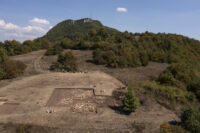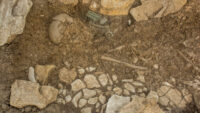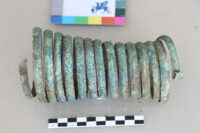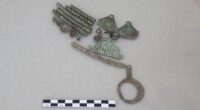 An archaeological excavation of the Kopilo burial ground in central Bosnia has discovered new forms of jewelry in several Bronze Age graves.
An archaeological excavation of the Kopilo burial ground in central Bosnia has discovered new forms of jewelry in several Bronze Age graves.
Kopilo is a hilltop settlement about 40 miles west of Sarajevo that was founded around 1300 B.C. It was a farming community on a plateau 2000 feet above sea level and was occupied continuously for a thousand years. Skeletons of pigs, cattle and goats have been found indicating livestock breeding. The pre-Illyrian Bronze and Iron Age culture that settled the site was known for its network of fortified hilltop settlements and metallurgic skill, but its funerary practices were little known. The Kopilo site has been excavated since 2019, but until 2021, only two tombs had been found.
 The settlement’s necropolis was finally discovered in 2021. This year the entire burial ground has been systematically excavated and documented. The tombs were built of stone surrounded by an outer ring of stone. Each contained two to five burials. The necropolis was in continuous use from the 11th to the 5th century B.C. Archaeologists have unearthed 46 graves containing the remains of 53 individuals. They were buried on their sides in the crouch burial position with legs and arms slightly bent. A small vessel was often buried at the head of the deceased. Early examinations of the osteological remains show a disproportionate number of young children indicating a high child mortality rate. Grave goods include pottery, bronze jewelry, glass beads and iron weapons.
The settlement’s necropolis was finally discovered in 2021. This year the entire burial ground has been systematically excavated and documented. The tombs were built of stone surrounded by an outer ring of stone. Each contained two to five burials. The necropolis was in continuous use from the 11th to the 5th century B.C. Archaeologists have unearthed 46 graves containing the remains of 53 individuals. They were buried on their sides in the crouch burial position with legs and arms slightly bent. A small vessel was often buried at the head of the deceased. Early examinations of the osteological remains show a disproportionate number of young children indicating a high child mortality rate. Grave goods include pottery, bronze jewelry, glass beads and iron weapons.
 The jewelry includes bronze fibulae in never-before-seen shapes. In addition to the new forms of jewelry now introduced for the first time, archaeologists also found some of the earliest worked iron objects in Bosnia, proving iron metallurgy was active at the site as early as the 9th-8th century B.C.
The jewelry includes bronze fibulae in never-before-seen shapes. In addition to the new forms of jewelry now introduced for the first time, archaeologists also found some of the earliest worked iron objects in Bosnia, proving iron metallurgy was active at the site as early as the 9th-8th century B.C.
Burials include both cremations and inhumations, which is very unusual in Bronze Age Europe. There is also evidence that the bones were moved over  time, likely when graves were reopened for later inhumations as there were a number of double and even triple burials.
time, likely when graves were reopened for later inhumations as there were a number of double and even triple burials.
The skeletal remains will be subjected to staple isotope analysis and ancient DNA analysis to determine any kinship relationships between the dead, where they were born and raised, what they ate and what diseases they suffered.